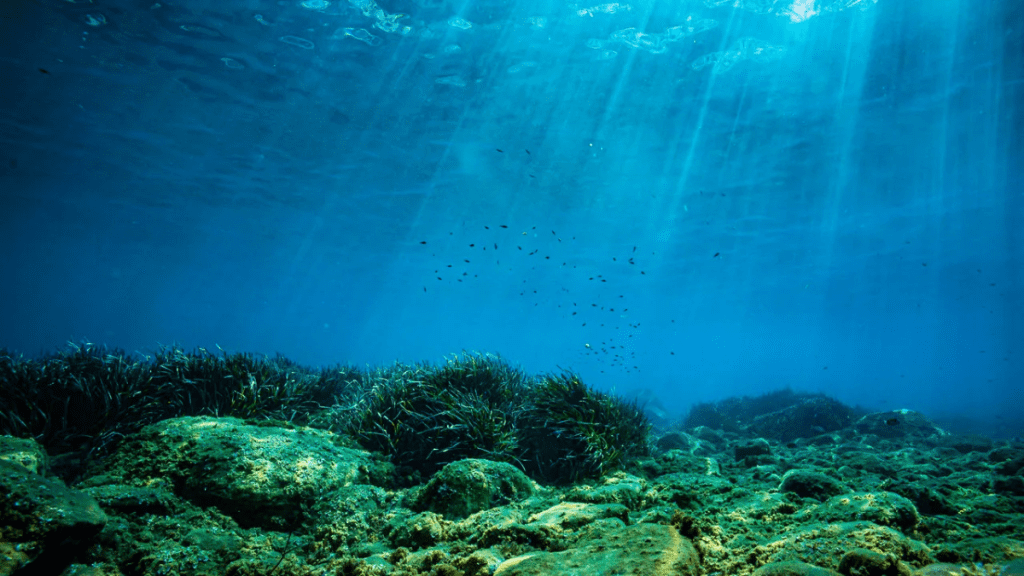
Our world is primarily made up of water, but a significant portion of the ocean floor is still unknown. Beneath the surface, there is a large underwater landscape that hosts unique and captivating environments.
The secret carbon storage under the sea
Some coral reefs have developed over thousands of years in total darkness. There are also hydrothermal vents, where organisms thrive in intense heat and pressure. However, the ocean floor does more than just support strange life forms—it quietly contributes significantly to managing our climate.
The ocean holds approximately 50 times more carbon than the atmosphere. A significant portion of this is found in the seafloor. Indeed, the top meter of seafloor sediment can store as much carbon as three meters of land soil. This makes it one of the most crucial natural carbon reservoirs on Earth.
Much of this carbon begins its path in the upper, sunlit parts of the ocean. Small organisms known as phytoplankton, which consist of tiny algae and bacteria, utilize sunlight to take in carbon dioxide and convert it into organic material. Part of this material descends to the ocean floor, where it gets trapped in sediments. A lesser portion of carbon originates from rivers, underground water, and dust from the land.
Just a small portion—under 1%—of the carbon absorbed by phytoplankton eventually makes its way to the ocean floor. However, when it does, it can remain trapped for millions of years if left undisturbed. This extended storage plays a role in keeping extra carbon dioxide from entering the atmosphere, thereby reducing the pace of global warming.
How human actions endanger underwater carbon deposits
The deep ocean may appear distant and untouched, but human actions are now affecting even its most isolated areas. Dredging and trawling, two types of bottom fishing, cause the most damage. In these methods, cages, chains, and heavy nets are pulled along the ocean floor. As a result, they stir up sediments and disrupt the carbon that is stored there.
When the ocean floor is agitated, the underlyingcarboncan be returned to the water. Microorganisms then decompose this carbon, generating carbon dioxide. A portion of this gas ultimately enters the atmosphere, increasing greenhouse gas concentrations.
Research indicates that bottom trawling by itself might emit anywhere from 0.03 to 0.37 gigatons of carbon dioxide annually. This is a wide range, and experts are continuing to investigate the precise figures. Additional actions—such as deep-sea mining, installing underwater cables, and constructing offshore facilities—can also disturb sediments and decrease carbon sequestration.
Mining is particularly alarming as it physically removes sections of the seafloor that have developed over thousands or even millions of years. Studies indicate that regions affected by mining may contain almost half the amount of stored carbon compared to undisturbed areas nearby. Furthermore, the harm extends beyond the immediate site—waste and sediments disturbed by mining activities can travel to other parts of the ocean, negatively impacting marine life in the process.
Safeguarding the ocean floor to preserve the climate
A method to minimize harm to the ocean floor is the establishment of Marine Protected Areas (MPAs). These are regions of the sea that have been set aside for long-term conservation. Approximately 8% of the global ocean is currently included in an MPA. Theoretically, these zones can aid in safeguarding carbon on the seafloor by restricting damaging practices such as bottom trawling.
However, the situation is more complex. Numerous MPAs are not effectively managed, and harmful fishing practices continue in significant areas of these zones. Only less than 3% of the ocean is classified as "highly protected," where activities that harm the seafloor are prohibited. In certain regions, trawling levels are even greater within MPAs compared to outside them.
When adequately funded and effectively implemented, marine protected areas can benefit both ocean wildlife and carbon sequestration. They can also generate economic value—certain research suggests that preserving 20–30% of the ocean could deliver trillions of dollars in ecological services annually. However, without robust regulations and enforcement, marine protected areas might have limited success in protecting carbon stored on the ocean floor.
Preserving the deep ocean offers advantages that go beyond climate change. Numerous organisms living on the ocean floor require a long time to regenerate following trawling activities. Bottom fishing also carries a significant carbon impact when compared to other food sources such as chicken or pork, and a substantial portion of the catch is discarded dead or injured. Meanwhile, mining operations can permanently damage unique deep-sea environments, along with the species that rely on them.
The ocean floor is not only composed of mud and sand—it plays an active role in Earth's climate system. Altering it could release carbon that has been securely stored for thousands of years, introducing another contributor to greenhouse gas emissions in an already heating planet.
The post 🔒 Seafloor safe — the quiet climate champion capturing 50 times more carbon than our atmosphere appeared first on Cleantech Times.
